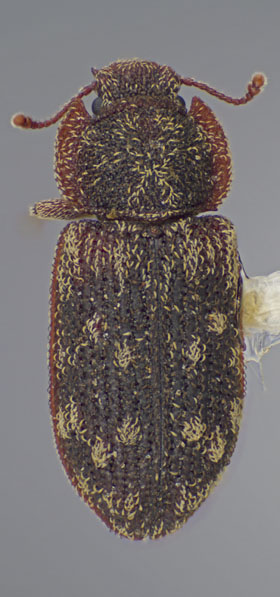 |
 Previous Genus Next Genus Previous Genus Next Genus 
Genus: Namunaria
Diagnostic Features
- Description: Antennae 11-segmented with a 2-segmented club. Antennal setation sparse. Subantennal grooves present, short, not reaching past eyes. Eyes round, well-developed, finely faceted. Eyes deeply emarginate anteriorly by projection of frons, forming a distinct canthus. Pronotal disc convex, without distinguishing sculpture. Pronotal lateral margins widest at middle, distinctly explanate, finely serrate. Procoxal cavities closed. Metacoxae narrowly separated, separation less than metacoxal length. Tarsal formula 4-4-4. Dorsal surface with patches of dark and pale, flattened, curved setae.
- Similar genera: The genus Namunaria is superficially similar in general appearance to Pseudocorticus. Pseudocorticus can be readily distinguished by the open procoxal cavities, antennae covered in dense, short, scale-like setae, antennal club one-segmented, lack of antennal grooves on head, and dorsum covered in short, scale-like setae.
Known Distribution
- Northwest (OR, WA), Southwest (CA), South Central (OK, TX, MS), North Central (IN, OH), Northeast (NJ, NY, MD, PA, WV, VA), Southeast (NC, TN) USA, Ontario and British Columbia, Canada.
Biology
- Namunaria has been collected at MV/UV lights and from under the bark of various dead hardwoods and conifers.
- Abundance: Moderately common
North American Species (2)
Species Diagnoses
- Namunaria guttulata: Antennal segment 3 1.5 times length of segment 4. Distribution: Indiana, New Jersey, New York, Ohio, Maryland, Pennsylvania, North Carolina, Mississippi, Tennessee, West Virginia, Virginia, Oklahoma, Texas, USA. Ontario, Canada.
- Namunaria pacifica: Antennal segment 3 subequal or only slightly larger than segment 4. Distribution: California, Oregon, Washington, USA; British Columbia, Canada.
Selected References
|
 |
 
Namunaria guttulata
© N.P. Lord |


